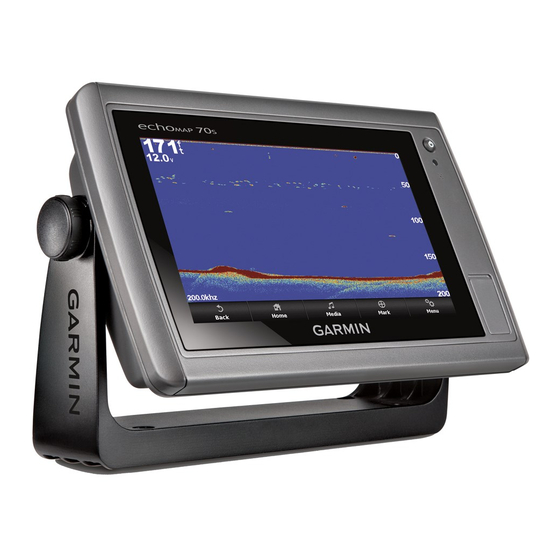- ページ 30
船舶用GPSシステム Garmin echomap 50 seriesのPDF オーナーズマニュアルをオンラインで閲覧またはダウンロードできます。Garmin echomap 50 series 44 ページ。 Flat-mount kit
Garmin echomap 50 series にも: クイック・スタート・マニュアル (4 ページ), オーナーズマニュアル (38 ページ), オーナーズマニュアル (30 ページ), 取付説明書 (6 ページ), オーナーズマニュアル (50 ページ), 取付説明書 (6 ページ), 取付説明書 (34 ページ)

Incoming Distress Calls
If your compatible chartplotter and VHF radio are connected
using NMEA 0183 or NMEA 2000, your chartplotter alerts you
when your VHF radio receives a DSC distress call. If position
information was sent with the distress call, that information is
also available and recorded with the call.
designates a distress call in the DSC list and marks the
position of the vessel on the Navigation chart at the time of the
DSC distress call.
Navigating to a Vessel in Distress
designates a distress call in the DSC list and marks the
position of a vessel on the Navigation chart at the time of the
DSC distress call.
1
Select Nav Info > Other Vessels > DSC List.
2
Select a position-report call.
3
Select Navigate To.
4
Select Go To or Route To.
Man-Overboard Distress Calls Initiated from a VHF
Radio
When the chartplotter is connected to a compatible VHF radio
with NMEA 2000, and you initiate a man-overboard DSC
distress call from the radio, the chartplotter shows the man-
overboard screen and prompts you to navigate to the man-
overboard point. If you have a compatible autopilot system
connected to the network, the chartplotter prompts you to start a
Williamson's turn to the man-overboard point.
If you cancel the man-overboard distress call on the radio, the
chartplotter screen prompting you to activate navigation to the
man-overboard location disappears.
Man-Overboard and SOS Distress Calls Initiated from
the Chartplotter
When your chartplotter is connected to a Garmin NMEA 2000
compatible radio and you mark an SOS or man-overboard
location, the radio shows the Distress Call page so you can
quickly initiate a distress call.
For information on placing distress calls from your radio, see the
VHF radio owner's manual. For information about marking an
MOB or SOS location, see
an MOB
Location.
Position Tracking
When you connect the chartplotter to a VHF radio using NMEA
0183, you can track vessels that send position reports.
This feature is also available with NMEA 2000, when the vessel
sends the correct PGN data (PGN 129808; DSC Call
Information).
Every position report call received is logged in the DSC list
(DSC
List).
Viewing a Position Report
1
Select Nav Info > Other Vessels > DSC List.
2
Select a position-report call.
3
Select an option:
• To switch to position report details, select .
• To switch to a Navigation chart marking the location,
select .
• To switch to a Navigation chart marking the location,
select Next Page.
• To view the position report details, select Previous Page.
Navigating to a Tracked Vessel
1
Select Nav Info > Other Vessels > DSC List.
2
Select a position-report call.
24
Marking and Starting Navigation to
3
Select Navigate To.
4
Select Go To or Route To.
Creating a Waypoint at the Position of a Tracked
Vessel
1
Select Nav Info > Other Vessels > DSC List.
2
Select a position-report call.
3
Select New Waypoint.
Editing Information in a Position Report
1
Select Nav Info > Other Vessels > DSC List.
2
Select a position-report call.
3
Select Edit.
• To enter the name of the vessel, select Name.
• To select a new symbol, select Symbol, if available.
• To enter a comment, select Comment.
• To show a trail line for the vessel if your radio is tracking
the position of the vessel, select Trail.
• To select a color for the trail line, select Trail Line.
Deleting a Position-Report Call
1
Select Nav Info > Other Vessels > DSC List.
2
Select a position-report call.
3
Select Edit > Clear Report.
Viewing Vessel Trails on the Chart
You can view trails for all tracked vessels on some chart views.
By default, a black line indicates the path of the vessel, a black
dot indicates each previously reported position of a tracked
vessel, and a blue flag indicates the last reported position of the
vessel.
1
From a chart or 3D chart view, select Menu > Other Vessels
> DSC Trails.
2
Select the number of hours to show tracked vessels on the
chart.
For example, if you select 4 Hours, all trail points that are
less than four hours old appear for all tracked vessels.
Individual Routine Calls
When you connect the chartplotter to a Garmin VHF radio, you
can use the chartplotter interface to set up an individual routine
call.
When setting up an individual routine call from your chartplotter,
you can select the DSC channel on which you want to
communicate. The radio transmits this request with your call.
Selecting a DSC Channel
NOTE: The selection of a DSC channel is limited to those
channels that are available in all frequency bands. The default
channel is 72. If you select a different channel, the chartplotter
uses that channel for subsequent calls until you call using
another channel.
1
Select Nav Info > Other Vessels > DSC List.
2
Select a vessel or a station to call.
3
Select Call with Radio > Channel.
4
Select an available channel.
Making an Individual Routine Call
NOTE: When initiating a call from the chartplotter, if the radio
does not have an MMSI number programmed, the radio will not
receive call information.
1
Select Nav Info > Other Vessels > DSC List.
2
Select a vessel or a station to call.
3
Select Call with Radio.
Digital Selective Calling
